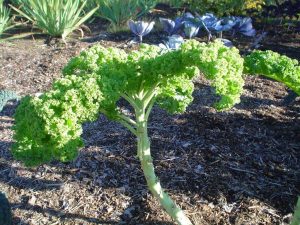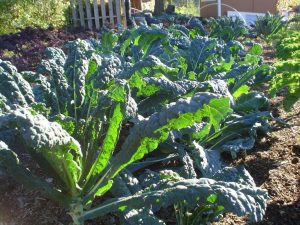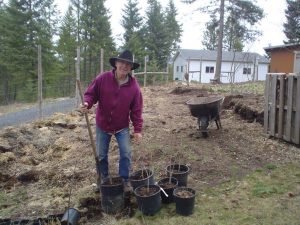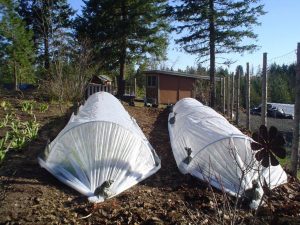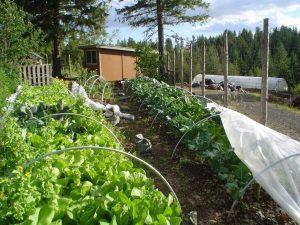Table of Contents
Kale—The Wonder Food
(From Volume 7 No. 2 Newsletter for November 2011)
Kale (Brassica oleracea) is a descendent of wild cabbage and originated in Asia Minor. It was thought to have been transported to Europe around 500 B.C by Celtic wanderers.
Varieties of Kale:
Winterbor kale after a full season of harvest. They look like little trees by the end of the season. Note the lack of weeds due to the heavy mulching. This plant loves leaf mulch!
Redbor Kale after a full season of harvest.
Dinosaur (Lacinato or Toscano) Kale in full swing. As it gets on into the season the leaves start to get a bit bitter. During this time we stop harvesting for human consumption and harvest for the chickens. They LOVE this stuff and it gives their eggs a deep orange highly-nutritious yolk. Of course all during the harvesting season the Girls get any produce that does not look perfect or fit for human consumption. It helps to cut down the feed bills and I think raw stuff is better for them.
Red Russian (Winter) Kale. This one has stems that seem a bit more rubbery so it’s harder to snap off the base stem when you’re harvesting.
Insect Control on Kale:
We think it’s important to keep harvesting the kale we think even through the cycles of insects because those cycles only last for a few short weeks and the small centers of the plant will grow out and still be edible, but if you leave the older insect-damaged leaves on the plant this leaves a breeding ground for the insects and they will reproduce. The following year you’ll have a bigger problem. If you feed the damaged leaves to the chickens, it will help to stop the reproduction of the insects. We don’t compost insect-infested vegetation.
Nutritional and Health Benefits of Kale
Kale, a cruciferous vegetable, is recognized to be one of the healthiest foods you can eat. I’m surprised that it’s not a more popular vegetable because of all its health benefits.
- Anti-cancer benefits from its glucosinolates, carotenoids (lutein and beta-carotene) and flavonoids. Kale has been researched a bunch lately. Studies discovered that the isothiocyanates in the kale help bladder, breast, colon, ovary and prostate cancer. Kale turns off bad genes that cause cancer.
- Antioxidants: Kale contains 45 different flavonoids (like Quercetin) which act as antioxidants and anti-inflammatories. Other cruciferous vegetables containing antioxidants include broccoli, cabbage, Brussels sprouts, cauliflower, collards, kohlrabi, pak choi but a surprising number of other vegetables are also in this family—see https://en.wikipedia.org/wiki/Cruciferous_vegetables
- Kale relieves oxidative stress responsible for diseases such as cataracts, atherosclerosis and COPD (Chronic Obstructive Pulmonary Disease)
- Decreases cholesterol: Kale works better at cholesterol removal when steamed because the fiber in it can bind better to bile acids in the digestive tract. This process is part of the cholesterol lowering effect.
- Detoxifies the liver by affecting both Phase I and Phase II detoxification. Kale helps to detoxify the body as all dark green leafy vegetables to because they support these liver functions.
- Anti-inflammatory
- High in Omega-3 Fatty Acids
- Excellent source of Vitamin K (better than any of the World’s Healthiest 135 Foods and twice the amount of other cruciferous foods.) See these foods here: https://www.whfoods.com/foodstoc.php
- Kale is an excellent or very good source of vitamin A, vitamin C, manganese, dietary fiber, copper, tryptophan, calcium, vitamin B6 and potassium. It is also quite good in iron, magnesium, vitamin E, vitamin B2, protein, Vitamin B1, folate, phosphorous and vitamin B3.
Dietary Suggestion: It is recommended to include 1 ½ cups cruciferous vegetables into your diet 2-3x/week minimum or more for their health benefits.
How to Pick the Best Kale to Eat: Kale should be firm, not wilted, fresh looking and have hardy (not floppy) stems. There should be no signs of browning, yellowing or holes. Smaller leaves are the most tender. From what I’ve read, kale’s peak time runs from the middle of winter through the beginning of spring, but it seems to grow best for us from spring to fall in our area. It’s considered a cole crop (not cold crop). “Cole” refers to any of various plants belonging to the Cruciferae or mustard family although most cole crops enjoy cold weather.
Storage of Kale: Store it in airtight bags in the refrigerator. It should keep for 5-10 days depending on how fresh it is. We’ve heard grocery stores rehydrate the kale by cutting off a bit of stem and soaking it in a bucket of warm water for an hour or two. Our suggestion is to purchase it as fresh as possible (like at a farmer’s market!) Extended storage makes the flavor bitter. One resource said not to wash it prior to storing because that encouraged spoilage. Our favorite way to use it is to pick it right off the main stem before chopping it up and stir frying it with onions, zucchini and a bit of garlic or pesto before adding the eggs to make a vegetable-packed omelet.
Whole Foods (www.whfoods.com) has several tasty looking recipes for kale. I featured Kale Slaws in the last newsletter: https://naturalhealthtechniques.com/kale-salads-and-slaws.htm
Michael and I love the Redbor and Winterbor varieties best. I noticed that insects in our no-spray gardens don’t seem to recognize the red plants as quickly so leave them alone—so Redbor is my all-time favorite. Other varieties include Dinosaur (Lacinato or Tuscan), ornamental (Salad Savoy) and Red Winter (Russian Red) kale. The Red Winter variety attracted more aphids than the green Winterbor varieties this year.
How to Grow Kale: We start our plants from seed inside around February and set the transplants out as soon as we can. We use row cover to protect the baby plants from the elements and from the white cabbage moths, flea beetles and aphids.
Here’s a photo of that process:
Michael preparing the bed mid-April of this year. We leveled the area out with flakes of old straw (on the left) and fortified each hole we dug for the transplants with soil we built from straw bale beds (see remainder of one of those beds on the right just behind the compost bin made of pallets.)
Transplants out under row cover (above)
We remove the row covers on warmer days unless we see those white cabbage moths or have a flea beetle problem (then we leave them on and take them off only when we harvest once a week.) These row covers have lasted through5 inchesof snow, several hail storms as well as hard rain and wind. Row covers make our Zone 5 growing area a Zone 6 and when used inside a greenhouse it makes the plants think they are in Zone 7 so these covers are a real boon to serious gardeners attempting season extension.
Here we planted broccoli in between the kale because it would be harvested before I started harvesting the kale. (Napa cabbage on the left side of the photo.)
Harvesting Kale: For kale, we harvest 3-5 of the largest lower leaves of the plant each week once the plant is about 16” tall. We weeded once in the beginning of the season and just plucked the few straggler weeds as the season progressed. What bliss! Since the plants were planted using permaculture deep mulch techniques we’re happy to say they only need a deep watering once a week even in the hottest summer days. We choose to water either the day before or after each harvest to help prevent any post-harvesting stress.
The plants like colder climates, so in the heat of the summer here in Zone 5 we don’t get a full harvest again until it starts to cool down. We have excellent luck heavily mulching the area with leaves. Cole crops like cool roots.
Seed Saving: If you want to save seed for the following year then let a plant or two overwinter (they don’t need protection) and it will flower and set pods the following year. I let an entire row go to seed last year intending to dig most of the plants up to feed the chickens but noticed that they were one of the first plants to bloom this year and the bees went crazy over them, so I left them and pulled them after other flowers started to bloom. We felt like we were doing our part to keep the bee populations happy.
Some Cautions and Comments about Kale:
- Kale does have a small amount of oxalate in it so people with gout may want to limit the amount of kale they eat. Of course there are many other foods with higher amounts of oxalates:https://naturalhealthtechniques.com/list-of-high-oxalate-foods.htm
- And if you’re on Coumadin meds, you’ll want to eat a consistent amount of greens each day so that your coumadin levels will be consistent in your body. You should discuss this with your medical doctor though. Usually they say not to eat anything green (but then, how does one live?) (See my handout on Coumadin and vitamin K foods: https://naturalhealthtechniques.com/coumadin-and-vitamin-k-foods.htm
- Non-organic kale is among the 12 foods on which pesticides have been most frequently found.
- Raw Kale in large volumes (along with the other cruciferous vegetables, peaches and pears) do have a goitrogenic effect on the body. I usually recommend limiting goitrogenic (thyroid hurting) foods to 4 cups/week maximum. Cooking inactivates this factor, so feel free to eat as much cooked as you want if you are on thyroid medicines. For more information on goitrogens go to:https://naturalhealthtechniques.com/specificdiseasesthyroidbadfoods.htm
Helpful Links and References for Kale:
- About Kale: https://www.whfoods.com/genpage.php?tname=foodspice&dbid=38
- The Dirty Dozen: Top 12 Fruits and Vegetables Containing the Most Pesticides: https://www.huffingtonpost.com/2011/06/13/dirty-dozen_n_875718.html#s290785&title=Apples
- How to Grow Kale: https://www.gardenaction.co.uk/fruit_veg_diary/kale-grow.asp
- Kale Facts: https://www.nutrition-and-you.com/kale.html
- Kale Chips: https://naturalhealthtechniques.com/kale-chips/
- Kale Slaws and Kale Salads: https://naturalhealthtechniques.com/kale-slaw-kale-salads-recipes/
